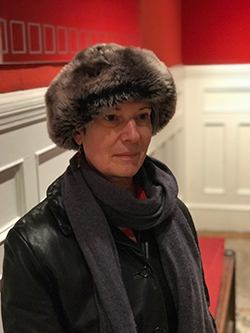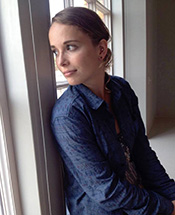A Peony to Pique the Senses: Chloe Hogan-Weihmann in Conversation with Jan Conn

Jan Conn, whose poem "Peony" appears in the Malahat's Winter 2017 issue, discusses synaptic clefts, peony seeds, and the onset of spring with Malahat volunteer Chloe Hogan-Weihmann.
Jan Conn’s ninth book, Tomorrow’s Bright White Light (Tightrope Books) was published in 2016. Previous books include Edge Effects (2012) and Botero’s Beautiful Horses (2009), both from Brick Books. Her poetry has received a CBC Literary Prize, the inaugural P.K. Page Founder’s Award, and was nominated for the Pat Lowther Award. Poems have been included in The Best Canadian Poetry 2009, 2012 and 2014. She is a member of the collaborative writing group Yoko’s Dogs who have published Whisk (Pedlar Press, 2013) and Rhinoceros (Gaspereau, 2016). She is also a biologist, and lives in western Massachusetts.
Do you think it's important that the reader seek out definitions of the scientific terminology in your poetry (such as "synaptic cleft" and "vesicle") in order to gain a fuller understanding of your work, or do you think the reader can "feel" the meaning you intend without knowing the exact biological function or mechanism to which you refer?
A reader could infer the transformation without having to know the specific meanings of synaptic cleft, vesicle, or neurotransmitter, but the poem would be richer and likely more resonant with this information in hand. It was spring when I began this poem, and it was refreshing to imagine that petals might replace or be interchangeable with neurotransmitters, moving inside my brain!
What made you choose a peony specifically as opposed to a different flower? What makes the peony an important symbol for you?
I chose peony because we have a very lovely one, a Japanese woodland peony, in our garden. It’s one of the first to flower, and the petals are ivory-coloured and elegant. The flower centre is a stellar pink. Later in the season, when the seed pods open, there are two vivid colours of seeds: the fuchsia ones, slightly smaller and a little wrinkled, are aborted, and will never germinate; but the bright indigo ones are viable. The fuchsia seeds are possibly a decoy for seed predators (birds or insects) – their brighter colour is attractive but they are not nutritious, so if the predator tastes then rejects them they might not try the indigo ones, which are interspersed among the fuchsia. It’s a trade-off. Some seeds are “sacrificed” so others can germinate.
Peonies are not symbolic to me, though I love the phrase poet Nyla Matuk used in a poem, “oligarchy of peonies.” It’s easy to imagine peonies being in charge, they’re a little full of themselves. On the other hand, a peony has many layers (of petals), and could, at a stretch, resemble a human cerebral cortex, perhaps something I was unconsciously considering.
Can you describe the effect you wish to achieve with the nontraditional structure of aligning certain verses to the right?
It’s one of many techniques to separate the voices. For this poem, I preferred the physical semi-separation rather than, for instance, different fonts. I’m partial to the way it looks on the page.
The left stanzas are in the voice of a younger self, or perhaps one part of a brain, a voice that begins in an interior, somewhat unsettled mode and then moves out into the world, only to find that a natural death (of a vole) has occurred. The right-aligned stanzas are envoiced by another part of a self or brain, a bit more analytical, differently imaginative. Of course, they are also in conversation, and linked by association.
Was the poem inspired by something that happened to you or was it purely from your mind? Can you talk a little bit about the genesis of this piece?
I wrote part of the more interior voice months ago, recalling some events from childhood, though in the present tense I often see and sometimes cradle efts – they are so orange! with oranger spots (what’s not to love)! I have an odd relationship with orange.
On my way to the airport on a back road at dawn this summer I saw a fox in flight or chasing down prey – the image was very charged – not sure why, but it seemed to want to be linked to the younger voice in this poem.
I’ve long been intrigued by transformation, so shifting from a cortex to a peony didn’t seem unusual to me. I enjoyed combining this with a seasonal shift to spring, the way our senses are all so piqued.
A focus on the human nervous system relates to my ongoing exploration of and desire for a deeper understanding of experienced and imagined mental states, and my many efforts to communicate them. Why not try texting?

Chloe Hogan-Weihmann
* * * * * * * *









